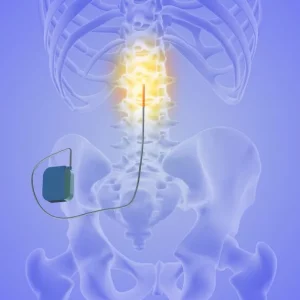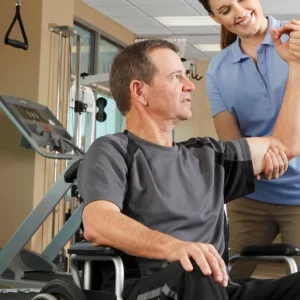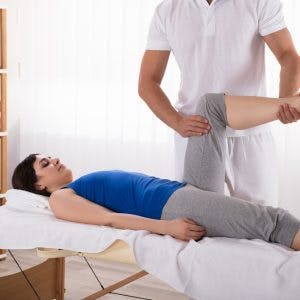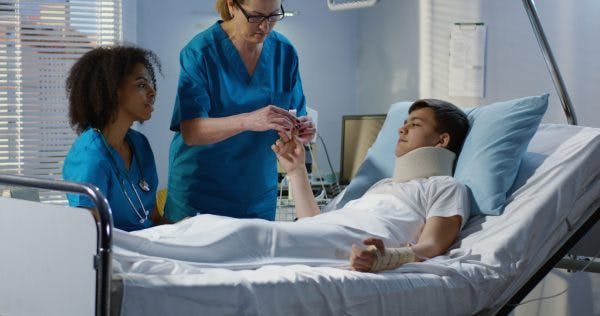Physical therapy plays an essential role in paraplegia rehabilitation after spinal cord injury. Every spinal cord injury is unique, so the personalized recovery plan that a physical therapist can create for you will help optimize recovery. This includes creating goals that are specific to your needs and providing interventions that directly promote achieving those goals.
Physical therapy helps individuals with paraplegia improve their mobility through highly repetitive, task-specific exercises. These exercises are designed to increase range of motion, strengthen the muscles, and improve overall physical function.
To help you understand the importance of physical therapy for paraplegia rehabilitation, this article will review spinal cord injury recovery and the various processes involved.
Goals of Physical Therapy for Paraplegia
Physical therapy for paraplegia primarily focuses on improving lower body mobility through repetitive, task-specific exercise. Exercise can be performed by individuals with paraplegia regardless of the level or severity of the injury.
Spinal cord injury recovery relies heavily on neuroplasticity, which is the nervous system’s ability to rewire itself and create new connections. By consistently practicing weakened movements, the spinal cord will perceive a demand for that function and adapt by rewiring and strengthening its neural pathways. Over time, this can improve performance of motor functions and increase independence with daily activities.
There are three major factors that influence neuroplasticity:
- Intensity involves how many repetitions you perform, how long you train, and how much you’re challenging yourself. The higher the intensity, the greater the recovery outcome. It is important, however, to allow for sufficient recovery time between exercise sessions.
- Specificity is necessary because the training of one function doesn’t necessarily transfer over to other functions. Every movement fires a different set of neural pathways in the spinal cord. This means it is important to practice the smaller, task-specific movements necessary for individual skills in addition to practicing bigger movements.
- Timing is essential because the most recovery typically occurs during the first six months following a spinal cord injury. The spinal cord temporarily experiences a heightened state of plasticity, which makes it easier to relearn functions during this window. However, it’s important to understand that the spinal cord always has neuroplasticity and recovery is possible even years after your SCI.
Physical therapy for paraplegia utilizes these three factors to promote optimal rehabilitation after spinal cord injury. Consistent practice will stimulate neuroadaptive changes in the spinal cord and promote functional improvements. Since we have discussed the basic methodology of physical therapy for paraplegia, let’s now review the various types of exercises physical therapy can consist of.
Physical Therapy Exercises for Paraplegia
During physical therapy sessions, a physical therapist will assess your functional abilities, create a personalized exercise plan, and guide you through exercises to maximize your mobility. Depending on the severity of your spinal cord injury, physical therapy for paraplegia recovery will involve different types of exercises. Since each individual with paraplegia has unique needs and functional abilities, every exercise plan should be unique as well.
For example, it’s not realistic for someone with no motor control in their legs to practice walking right away. Before this occurs, physical therapy treatment will focus on smaller movements and goals to maximize function and independence. This starting focus might be bed mobility, sitting balance, and flexibility at the beginning of physical therapy. Then, as you progress, treatment may evolve and start to focus on more advanced skills such as car transfers and walking when appropriate.
Physical therapy for individuals with paraplegia will consist of a variety of exercise types to address all aspects of spinal cord injury rehabilitation. In the following sections, we’ll discuss how different types of exercise can help individuals with paraplegia improve their mobility.
Stretching
Many individuals with paraplegia experience involuntary muscle contractions called spasticity. Spasticity occurs due to disrupted communication between the brain and muscles, causing misfiring or spasm of the affected muscle groups. Stretching the legs can help lengthen spastic muscles and minimize pain caused by additional pressure on the joints.
The effects of stretching can last for hours and help prevent injuries during more strenuous exercise. Well-stretched muscles can bear more pressure and achieve full range of motion, which makes it easier to perform more active forms of exercise. Additionally, frequent stretching can help reduce risk of developing further complications from paraplegia, such as muscle contractures.
Passive Range of Motion Exercises
Even if you have no motor control in your legs, individuals with paraplegia can benefit from physical therapy. Physical therapy for those with severe paraplegia typically involves practicing passive range of motion exercises.
During passive exercise, someone else can move your paralyzed limbs for you. However, most individuals with paraplegia should be able to use their arms to move their legs through their range of motion. Practicing passive range of motion exercises will help prevent joint stiffness, promote circulation, and stimulate the spinal cord.
Strengthening Exercises
Due to limited motor control in the legs, many individuals with paraplegia become less physically active. Lack of movement and decreased weight-bearing after spinal cord injury can cause the muscles to shrink, known as atrophy. Individuals with muscle atrophy are more susceptible to falls, fractures, poor circulation, and decreased metabolic rate.
Strengthening exercises are an essential part of physical therapy for paraplegia because they help maintain muscle mass and improve function. Additionally, strengthening exercises can be accompanied by electrical stimulation to help promote muscle engagement and the creation of new motor pathways.
Consistent practice of repetitive strengthening exercise is one of the best ways to improve functional mobility after a spinal cord injury. This does not only include exercises focusing on strength of the lower body, but also the core and upper body. These muscle groups are all vital for recovery for individuals with paraplegia.
Practicing these strengthening exercises at physical therapy and at home will allow you to overcome functional deficits and improve performance of daily activities. Additionally, practicing smaller strengthening exercises for individual muscles or tasks will improve execution of larger tasks such as transfers and walking.
Gait Training
Gait training is a type of physical therapy that focuses on learning to walk again after paraplegia. It often involves the use of supportive devices like parallel bars, walkers, and weight-bearing equipment. Gait training not only focuses on developing coordination and strength in the legs, but also on building balance and stability through the core. For example, you’ll learn how to stand and shift your weight from one side to the other without losing stability, which is a necessary component of walking.
Generally, gait training will focus on improving form and safety during upright mobility. To do this, individuals may use a harness to provide bodyweight support while using a treadmill. Additionally, aquatic physical therapy can be another great option for individuals with paraplegia to practice gait training. Performing walking and other strengthening exercises in the pool allows for buoyancy and increased support while still working against resistance from the water.
As patients improve their form and develop more strength in the legs, they’ll gradually be able to bear more weight through their hips, knees, and ankles. This increased strength and stability allows for more independence with mobility, even if assistive equipment is needed.
The likelihood of regaining the ability to walk after a spinal cord injury depends largely on whether the injury is complete or incomplete. For example, individuals with paraplegia who have an incomplete spinal cord injury have around an 80% chance of regaining some walking ability through rehabilitation. This number is significantly smaller for individuals with more severe or complete injuries, however.
How Long Do I Need to Participate in Physical Therapy for Paraplegia?
Every spinal cord injury is unique and paraplegia recovery time will vary for each individual. As previously mentioned, intensity, specificity, and time play critical roles in the recovery process.
Individuals must be willing to put in the effort to recover. What many people don’t realize is that the exercises practiced in a physical therapy session are usually not enough to create major, lasting improvements in function. Thousands of repetitions are required to promote neuroadaptive changes in the spinal cord. This means it’s essential to also practice at home between physical therapy sessions.
Interactive neurorehabilitation devices can help motivate spinal cord injury survivors to be consistent with physical therapy exercises at home. For example, the FitMi home therapy system helps target the full body and encourages hundreds of repetitions per half-hour session. Generally, individuals who intensely pursue rehabilitation improve quicker and ultimately require less physical therapy. This often makes it worth investing in physical therapy tools that help motivate a consistent regimen.
It’s also important to understand that recovery is not linear. The spinal cord never runs out of neuroplasticity and individuals can improve years after their injury. Even after periods of no noticeable progress, recovery is possible as long as you continue to practice weakened movements.
The Importance of Physical Therapy for Paraplegia Recovery
Physical therapy does not guarantee a full recovery from paraplegia, but it will help stimulate neural pathways in the spinal cord to improve motor function. Highly repetitive, task-specific exercise is essential for promoting neuroplasticity in the spinal cord, and physical therapy will guide individuals through exercises that can help. Additionally, participation in physical therapy helps minimize the risk of complications like stiffness, muscle atrophy, and poor circulation.
Hopefully this article helped you understand the importance of physical therapy for paraplegia recovery. Through time, consistency, and dedication, individuals with paraplegia can improve function and performance of daily activities to regain independence and improve quality of life.










